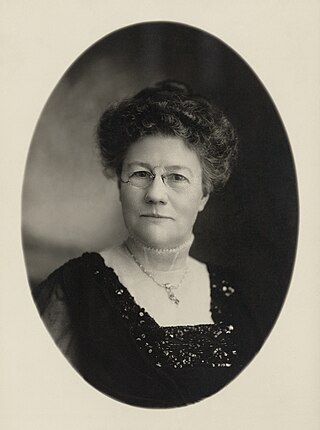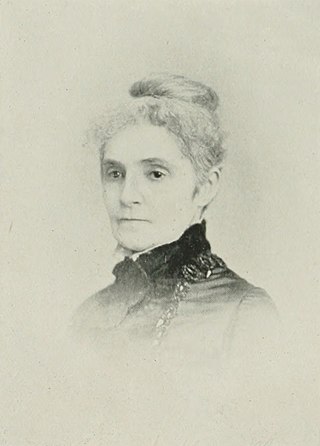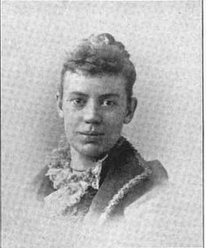Related Research Articles

Timothy Dwight was an American academic and educator, a Congregationalist minister, theologian, and author. He was the eighth president of Yale College (1795–1817).

Mary Burnett Talbert was an American orator, activist, suffragist and reformer. In 2005, Talbert was inducted into the National Women's Hall of Fame.

Elizabeth Oakes Smith was a poet, fiction writer, editor, lecturer, and women's rights activist whose career spanned six decades, from the 1830s to the 1880s. Most well-known at the start of her professional career for her poem "The Sinless Child" which appeared in the Southern Literary Messenger in 1842, her reputation today rests on her feminist writings, including "Woman and Her Needs", a series of essays published in the New York Tribune between 1850 and 1851 that argued for women's spiritual and intellectual capacities as well as women's equal rights to political and economic opportunities, including rights of franchise and higher education.

Ida Husted Harper was an American author, journalist, columnist, and suffragist, as well as the author of a three-volume biography of suffrage leader Susan B. Anthony at Anthony's request. Harper also co-edited and collaborated with Anthony on volume four (1902) of the six-volume History of Woman Suffrage and completed the project by solo writing volumes five and six (1922) after Anthony's death. In addition, Harper served as secretary of the Indiana chapter of the National Woman Suffrage Association, became a prominent figure in the women's suffrage movement in the U.S., and wrote columns on women's issues for numerous newspapers across the United States. Harper traveled extensively, delivered lectures in support of women's rights, handled press relations for a women's suffrage amendment in California, headed the National American Woman Suffrage Association's national press bureau in New York City and the editorial correspondence department of the Leslie Bureau of Suffrage Education in Washington, D.C., and chaired the press committee of the International Council of Women.
Mary B. Thistlethwaite Birdsall was an American suffragette, temperance worker, and journalist.

Harriett Ellen Grannis Arey was a 19th-century American educator, author, editor, and publisher. Hailing from Vermont, she was one of the earliest young women who studied in a co-educational environment. In Cleveland, Ohio, she became a contributor to The Daily Cleveland Herald and taught at a girls' school. After marriage, she moved to Wisconsin, and served as "Preceptress and Teacher of English Literature, French, and Drawing" at State Normal School in Whitewater, Wisconsin. After returning to Cleveland, she edited a monthly publication devoted to charitable work, and served on the board of the Woman's Christian Association. Arey was a co-founder and first president of the Ohio Woman's Press Association. Her principal writings were Household Songs and Other Poems and Home and School Training. Arey died in 1901.

Emily Thornton Charles was a 19th-century American poet, journalist, editor, and newspaper founder. Married in 1861 and widowed in 1869, she was left with two children to support. In 1874, she began a successful career as a journalist, at first as correspondent and reporter for various newspapers, and later as editor. She was associate editor of the book entitled Eminent men of Indiana. In 1881, she became managing editor of the Washington World and was the founder, manager and editor of the National Veteran at Washington, D.C. She was actively identified with the National woman suffrage convention, the Woman's National Press Association, and the Society of American Authors. Her published writings, under the pseudonym "Emily Hawthorne," include Hawthorne Blossoms (1876); and Lyrical Poems, Songs, Pastorals, War Poems, and Madrigals (1886). Charles favored woman's suffrage. She died in 1895.

Irene Williams Coit won a reputation by being the first woman passing the Yale College entrance examination in 1891, an event that was instrumental to the cause of co-education in American colleges.

Mary Elizabeth Beauchamp was an English-born American educator and author. She wrote about the Haudenosaunee, and served as secretary for her younger brother, William Martin Beauchamp, the ethnologist. Her notable works include Handbook of Wells Cathedral (1856) and The Emigrant's Quest (1867).

Helen A. Manville was an American poet and litterateur of the long nineteenth century. Under the pen name of "Nellie A. Mann", she contributed largely for leading periodicals east and west, and obtained a national reputation as a writer of acceptable verse. At the height of her fame, she decided to stop using the pen name and assume her own. She succeeded in making both names familiar, virtually winning laurels for two cognomens, when ill-health required a pause in her literary work. A collection of her poems was published in 1875, under the title of Heart Echoes, which contained a small proportion of her many verses.

Emma E. Bower was an American physician, and a newspaper owner, publisher, and editor. She was also an active clubwoman. Bower practiced medicine in Detroit, Michigan before returning to Ann Arbor, Michigan where, from 1896 to 1904, she owned, published, and edited a county paper, the Ann Arbor Democrat. For nine years, she was a member of the Ann Arbor board of education, during such time holding the office of president and treasurer. She served as treasurer of the Michigan Woman's Press Association, secretary-treasurer of the Michigan State Fraternal Congress, and held the office of president of the National Fraternal Press Association. She was the Great Record Keeper of the Ladies of the Maccabees.

Pauline Periwinkle was the pen name of S. Isadore Callaway an American journalist, poet, teacher, and feminist of the long nineteenth century. She served as the first corresponding secretary of the Michigan Woman's Press Association and was a staff member of Good Health, Battle Creek, Michigan. Using the pen name of "Pauline Periwinkle", Miner was the founder and editor of the "Woman's Century" page of The Dallas Morning News. She was "one of the most widely-read columnists in the early twentieth century."

Martha E. Sewall Curtis was an American woman suffragist and writer. She delivered notable lectures at the meetings of the National Woman Suffrage Association in Boston. For years, she edited a weekly woman's column in the News, of Woburn, Massachusetts, and was president of the Woburn Equal Suffrage League. For a number of years, she conducted in Boston a bureau of stenography and employed about 20 women. Her publications included Burlington Church (1885), Burlington (1890), and Ye olde meeting house (1909).

Elizabeth M. Olmsted was an American poet of the long nineteenth century. Her poems were well known during the Civil War, and appeared in the newspapers and magazines of that period.

Alice Ives Breed was an American social leader, salonnière, and clubwoman. She excelled as an organizer, using her executive abilities in religious, philanthropic, literary and social channels, aiming to improve the community.

Fanny Purdy Palmer was an American author, poet, journalist, lecturer, social activist, and clubwoman. She began club work in 1876 and was one of the originators of the General Federation of Women's Clubs. She served as president of the Rhode Island Woman's Club, was a member of the school committee of the city of Providence, Rhode Island, and was connected with various philanthropic and social movements, including women's suffrage. A diligent reader of some of the best scientific and metaphysical works, for many years, she was a writer of stories which appeared in various weekly and monthly publications, stories which have dealt with the problems of life.

M. Wintermute was an American author and poet whose poems appeared in The Youth's Companion, as well as other papers and magazines. She was a writer of some celebrity, and the author of a volume entitled Eleven Women and Thirteen Men (1887).

Nettie Leila Michel was an American business woman, author, and magazine editor of the long nineteenth century. Michel was the first woman commercial traveler in the U.S. and early in life traveled through Michigan for the N. K. Fairbank Company, of Chicago. She later gave up traveling and became the first editor of a strictly literary magazine, being associated with Charles Wells Moulton in Buffalo, New York, on The Magazine of Poetry, and with Mary Livermore in literary work.

Mary A. Ripley was an American author, lecturer, and teacher. She taught in the schools of Buffalo, New York for 40 years, including 13 in the grammar schools and 27 in the high school. The Mary A. Ripley Memorial Library inside the Women's Educational and Industrial Union of Buffalo was named in her honor.

Ada Josephine Todd was an American author and educator.
References
- 1 2 3 4 5 6 7 8 Willard, Frances Elizabeth, 1839-1898; Livermore, Mary Ashton Rice, 1820-1905 (1893). A woman of the century; fourteen hundred-seventy biographical sketches accompanied by portraits of leading American women in all walks of life. Buffalo, N.Y., Moulton. p. 124 . Retrieved 8 August 2017.
 This article incorporates text from this source, which is in the public domain .
This article incorporates text from this source, which is in the public domain . - ↑ "Mrs. M. Sears Brooks Dead - 02 Nov 1893, Thu • Page 5". The Indianapolis Journal: 5. 1893. Retrieved 9 September 2017.
- 1 2 "Literary Lady Dead - 03 Nov 1893, Fri • Page 2". The Public Ledger: 2. 1893. Retrieved 9 September 2017.
- ↑ White, Barbara A. (7 May 2013). American Women's Fiction, 1790-1870: A Reference Guide. Routledge. pp. 205–. ISBN 978-1-136-29092-3.